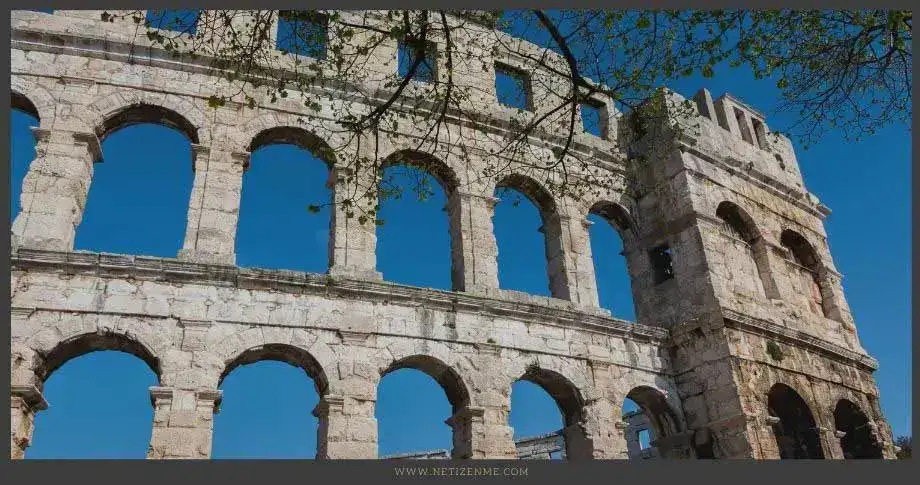
Sophisticated Roman Technology
“All roads lead to Rome” This saying was particularly true during the height of the Roman Empire when 50,000 miles worth of roads stemmed from the capital. At its height, the Roman Empire consisted of around 1.7 million square miles of land. To control and administer such an area, roman engineers built a sophisticated road system that was alien to the ancient world, and some of those roads are still in use. The standards set by the roman engineers for constructing the roads were rigorous. They used a combination of dirt, gravel, and bricks made from granite or hardened volcanic lava for construction, and the shape of the highways was kept straight arrow-headed with curves for water drainage.
The intelligence from every corner of the roman empire reached Rome with astonishing speed, and the Roman legions could march up to 25 miles a day and were able to keep the whole kingdom under control and make further conquests through these roads.
Roman Concrete:
“Roman concrete has passed the test of time.” Roman concrete was a significant breakthrough in the technological advancement of Rome and helped them build structures that are standing tall to this day. “Roman builders discovered that adding crushed terracotta to the mortar created a strong hydraulic mixture which could be used as a waterproof material for cisterns or other constructions exposed to the weather.” It was much stronger, time-efficient, and more flexible than other materials used in the ancient world. Ancient structures such as Roman Forum, Colosseum, and the Pantheon have survived the change of time and are still standing tall and strong only because of the roman concrete and their ingenious design. Romans addition, s used lime and volcanic rock to create underwater concrete to construct harbors.
Aqueducts:
The Romans and the city of Rome enjoyed many privileges like public toilets, public baths, underground sewage systems, and fountains. All these innovations were made possible only because of the Roman aqueducts. Romans used gravity to transport water through pipes made up of lead and concrete to the cities. These engineering marvels provided an almost continuous flow of fresh water to the towns and removed their dependence on the nearby water source. Although the system of aqueducts and irrigation canals existed way before the Romans, the Roman engineers used their technological advancement and knowledge to perfect this system to such an extent that some aqueducts transported water as far as 60 miles, astonishing in that era.
Roman Arches:
Arches existed long before the Romans; the Romans were the first civilization to harness and use their potential to the full extent in constructing large structures such as monuments and aqueducts. Romans first created a wooden arch and used concrete and other materials to make the stonework around it. When Keystone, the centermost stone at the top of the arch, was placed, the wooden arch was removed. The ingenious design of the hook helped them distribute the structure’s weight evenly around all supports, which helped large buildings stand tall and not crumble under their weight.
Medical Technology:
Romans improved ancient medical technology and invented many new and improved tools for surgery. Their mastery of battlefield medicine was so vital that the Roman soldiers, with the risk of being harmed during wars, lived longer than the average citizens. Romans established the first military medical corps and battlefield surgery units. The Roman medical company helped to control the spread of diseases in legions by managing the sanitation system effectively. The battlefield surgery unit saved countless lives by using new surgery methods and arterial surgical clamps to curb blood loss.
Agriculture:
The Romans improved the way of agriculture drastically, resulting in higher crop production and higher wealth in the kingdom. They invented much new agricultural equipment such as wheel plows, and Oxen drew harvesting machines with much greater accuracy and speed. The Romans also experimented with genetic modifications and greenhouses. Other techniques used by the Romans included grafting, manuring, crop rotation, etc. Romans were also excellent animal breeders thanks to their advancement in medicine and other technologies. Romans also bread sea life in artificial environments.
Roman engineers were always working to conquer the natural world and test the limits of physics. They gave the world so much to improve, and their technology and scientific knowledge were used for centuries.

- How Did Geography Affect the Indian Ocean Trade Routes?

- A Comparative Analysis of the Parthenon and Maison Carrée

- Silk Road’s Impact: Catalyst for Technological Advancements

This article is written by:

Nisar Ahmad
Nisar is a passionate content writer and loves to share his ideas about the world. He an energetic self persuasive author who loves to composes and plans to develop himself and his readers with every one of his steps.





